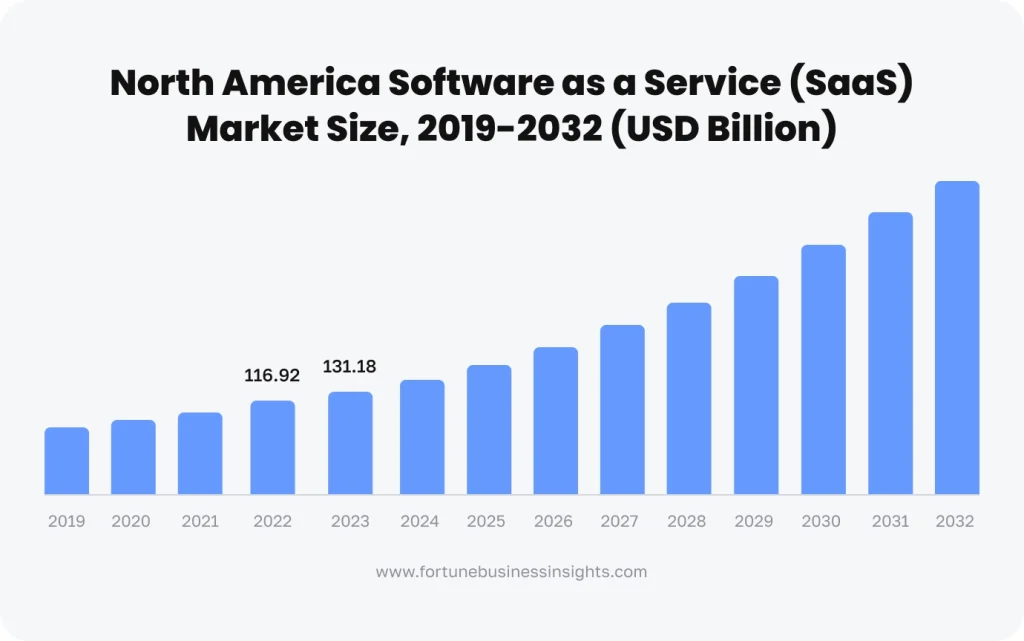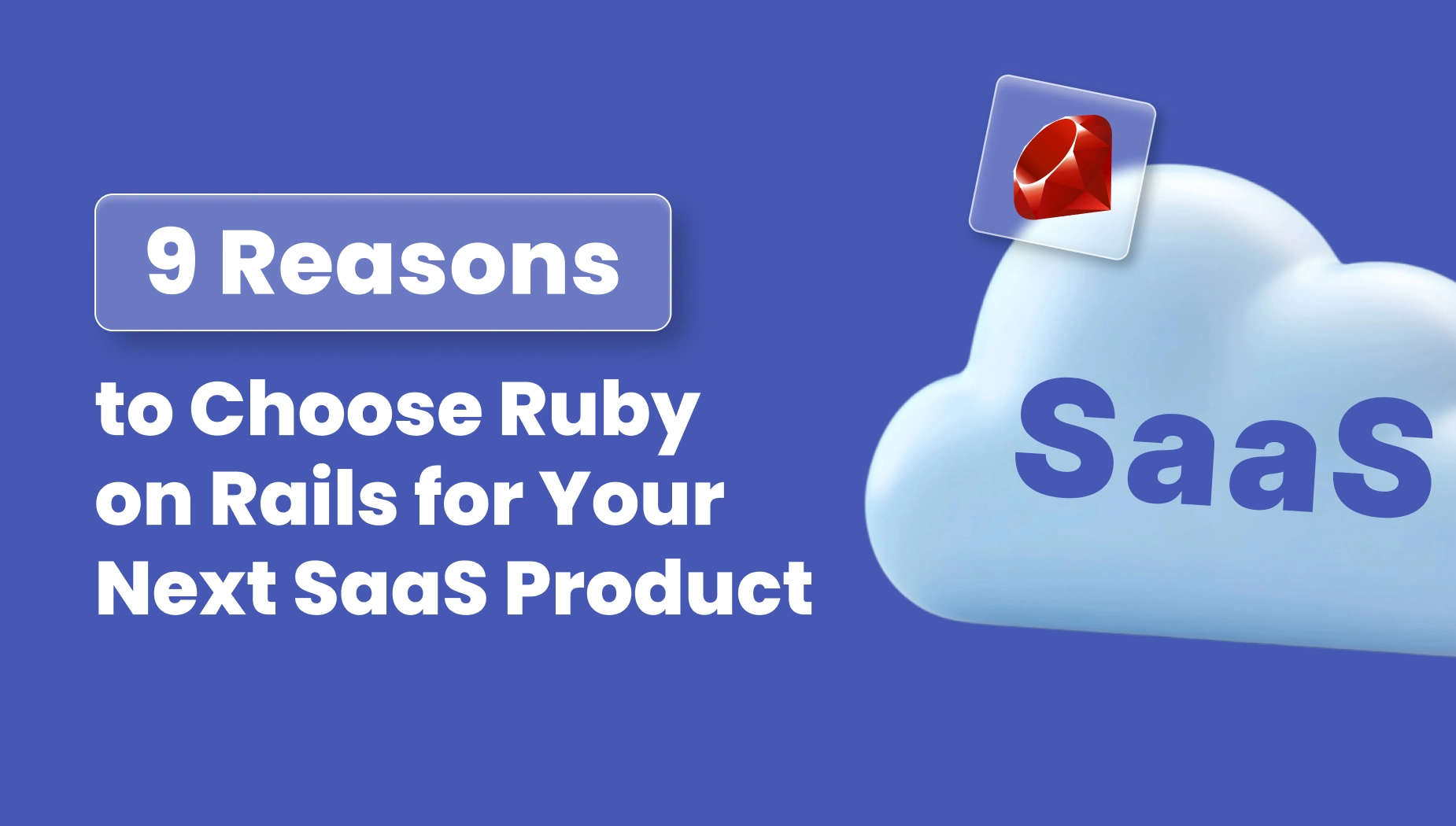Table of Contents
Developing a Software as a Service (SaaS) product can feel like navigating a maze.
There’s an endless list of decisions to make.
The tech side alone can leave you spinning.
Should you go with something simple and fast? Or flexible but time-consuming? And what if the clock’s ticking, your budget’s tight, and the pressure’s on to get it right the first time?
With so many technology options available, narrowing down the choices might seem overwhelming.
And the SaaS sector doesn’t stand still. The global Software as a Service (SaaS) market size is forecast to grow from $317.55 billion in 2024 to a mind-blowing $1,228.87 billion by 2032.

It clearly shows harsh competition, so you should opt for the best SaaS frameworks.
After doing some research, you must have heard about Ruby on Rails (RoR) and rumors around it.
Why Ruby on Rails, exactly? Is it the right choice for a SaaS idea? Is Ruby on Rails dead? Is Ruby on Rails still relevant?
These questions pop up regularly.
And we’ve got answers.
Yes, it’s a robust fit for any SaaS project. And no, it’s not dead at all.
Ruby on Rails (RoR) has gained a solid reputation for its ability to deliver fast, scalable, and secure web apps and websites.
In this article, we’re going to dive deeper into why Rails SaaS works so well.
“As a software engineer, I’ve worked with many frameworks, but Ruby on Rails stands out for how it simplifies the complex. It’s like having a well-organized toolbox where everything you need is right there, ready to go. This allows us to spend more time crafting meaningful features that truly make a difference for our clients and their users.”
— Daniil, Software Engineer at JetRuby
Key takeaways
- Rails’ “convention over configuration” approach and built-in tools allow developers to create features faster and reduce time-to-market.
- With nearly two decades of use, Ruby on Rails has a proven track record of handling complex SaaS projects, offering stability and a robust developer toolkit.
- Techniques like caching, lazy loading, and seamless hosting compatibility ensure Rails can support growing user bases and traffic spikes.
- Successful SaaS products require ongoing updates and improvements. Rails leverage active community and robust support that bring long-term viability.
- Rails promotes rapid development, but SaaS teams must balance quick iterations with simple Ruby on Rails testing tools to maintain reliability and prevent technical debt.
Why Ruby on Rails? 9 Advantages of Ruby on Rails that make it the best framework for SaaS applications
Unlike traditional software, where users download and run the program on their own devices, SaaS operates entirely online.
This means the software must be accessible, intuitive, and reliable every single time. Every single minute.
And when you create a SaaS product, speed and efficiency are key. Because you want to get to market as quickly as possible.
Rails helps you do that.
Ruby on Rails is a development framework that’s been quietly empowering some of the most successful SaaS products for over a decade.
Why? Because it simplifies the chaos. No extra fluff, no unnecessary complexity.
And it provides everything you need in one package, so you don’t waste time reinventing the wheel.
Let’s look at these Ruby on Rails benefits.
Fast development
Faster development means faster time-to-market.
So let’s start with one of RoR development’s best-known traits: speed.
Ruby on Rails follows a principle called convention over configuration.
Conventions are a set of rules that guide developers through building things the “Rails way.”
This means the framework has many built-in rules for how to structure your code. Instead of setting up everything from scratch, you can rely on these guidelines to build features faster.
Another big advantage is that Rails is already configured and ready to use right away, so developers don’t have to spend time customizing or selecting components.
For example, Ruby on Rails web developers don’t have to build basic elements like logins or user profile pages because Ruby on Rails already has tools for that.
Framework maturity
“Okay, so it’s fast. But is it reliable?”
“How do we know it won’t crash when things get complicated?”
A fair point.
Rails has been around since 2004, which might seem like forever in the tech world.
But this is a good thing.
A mature framework means it’s been tested over and over again in real-world projects. It also means developers have already tackled and solved most of the common issues you might face.
This approach results in fewer bugs, reliable libraries, and robust developer tools.
Ruby on Rails also has a huge development community that improves it constantly.
A gentle learning curve
However, not every developer has years of experience with every framework. What if your team includes juniors or newcomers?
According to The Rails Doctrine, “programmer happiness” is the #1 pillar of Ruby on Rails.
This framework proved to be beginner-friendly because it organizes code in a consistent and predictable way. This structure makes it easier for developers to understand the code. And it’s twice as important when multiple experts work on the same project.
Rails goes even further to help developers by using a Domain-Specific Language (DSL). A DSL is a mini, specialized language used within a larger programming language. It’s a special syntax for describing a specific part or function of your application.
As you already know, Rails is based on Ruby. This programming language has a natural syntax that feels almost like writing sentences in English. Combine it with Rails’ DSL and conventions methods, and you get the code that is intuitive and easy to follow.
Rails also provide helpful error messages, which guide developers when they make mistakes.
Seamless integrations
Most SaaS products don’t exist in a vacuum. They must connect with other tools and services like payments, email, analytics, CRMs, or customer support.
Ruby on Rails makes external integration relatively simple with pre-built Ruby gems.
These are reusable libraries of code that you can plug into your app. Many of these gems handle integration with third-party services, like Stripe for payments or SendGrid for emails, in just a few lines of code.
For example, A SaaS product can use a Stripe gem to handle credit card transactions or a Twilio gem to add messaging capabilities.
Rock-solid security
If your SaaS app handles customer data, security is mandatory. Rails comes with built-in tools to protect your app from common vulnerabilities.
- SQL injection protection. Rails uses something called “Active Record Query Interface.” This tool ensures that any data entered into your app is automatically cleaned before being sent to your database. This process stops hackers from injecting harmful commands to steal or manipulate data.
- Cross-site scripting (XSS) protection. Rails has a built-in tool called “Auto-escaping.” It automatically cleans up any data displayed in your app to prevent attackers from injecting harmful scripts that could run in a user’s browser.
- Cross-site request forgery (CSRF) protection. Rails includes a system to generate a unique “authenticity token” for every form submitted in your app. This token ensures that the actions (like transferring money or updating user data) are legitimate and come from a trusted user, not a fake or malicious source.
It also has tools for enforcing SSL encryption, ensuring data is transmitted securely.
Framework performance
“But can it handle a growing number of users?”
“What about spikes in traffic?”
People sometimes wonder if Rails is “fast enough” for modern apps.
The answer is yes. With the right setup, Rails can handle heavy traffic and demanding workloads.
It might not be the fastest framework, but it balances performance and ease of use.
What exactly makes Rails perform well?
Rails uses a combination of techniques, like caching and lazy loading, to ensure fast load times and efficient data processing.
Instead of loading all data at once, Rails loads only what’s needed and when it’s needed. That’s what lazy loading does.
As your app grows, Rails allows you to optimize performance with more advanced features. Recent 8.0 upgrades have improved processing speed and database efficiency.
Rails also works seamlessly with modern hosting services like AWS and Heroku, which provide the infrastructure needed to handle large numbers of users.
ROR flexibility
SaaS products evolve. You might start with a simple idea, but later you need to add features or pivot down the line. Rails makes it easier to adapt.
What exactly makes Rails flexible?
Its modular structure allows developers to update parts of the app without breaking everything else. If you need to customize any aspect of your SaaS product, RoR is flexible enough to adapt to your specific needs.
For example, you can add a new payment gateway or redesign a user interface without touching the core business logic.
If you’re running a SaaS for project management, you can seamlessly tweak the framework to handle unique workflows, like assigning tasks or generating reports.
Rapid prototyping
When building a SaaS, you must validate your ideas before building a fully-functioning product.
Ruby on Rails is perfect for this due to its built-in tools and Rails generators. Rails generators help developers quickly set up components like models, controllers, and views.
Additionally, Ruby on Rails leverages ready-made solutions like Devise for user authentication and ActiveAdmin for building admin interfaces.
RoR can handle common operations like creating, updating, and deleting records with minimal configuration. This allows teams to quickly test the core features of a product without building complex logic from scratch.
Monolithic architecture
RoR traditionally uses a monolithic architecture based on the model-view-controller (MVC) pattern. This approach organizes your code in a way that’s easy to manage and maintain.
What does MVC mean? In simple terms, it separates your app’s data (Model), user interface (View), and how they interact (Controller).
As a result, the code is more organized and less prone to errors.
If the project follows Rails conventions, most Rails developers will instantly recognize the structure and get started immediately.
The code for the entire application (front-end and back-end) is housed in a single codebase. This simplifies development, as developers don’t need to manage multiple services or repositories.
Rapid Team Expansion
Scale your team quickly without wasting time or resources on hiring. Choose our staff augmentation solution and get the talent you need, when you need it.
Hire Rails developersPopular SaaS solutions built with Ruby on Rails
Ruby on Rails has powered some of the most well-known SaaS platforms worldwide. These companies rely on Rails framework for its speed, flexibility, and ability to handle complex operations.
Basecamp
Basecamp is a project management tool that helps teams stay organized and productive.
It’s also the birthplace of Ruby on Rails.
David Heinemeier Hansson, Basecamp’s co-founder, created this framework to boost development while solving real-world coding challenges.
- Rails’ modular structure and ready-to-use components made it easier to develop features like to-do lists, file sharing, team communication, task tracking, messaging, and file sharing.
- Because Rails simplifies routine coding tasks, Basecamp launched faster, which gave them an edge in the competitive software market.
Hey
The same team behind Basecamp built Hey, a modern email platform designed to simplify inbox management. It prioritizes important messages, blocks unwanted emails, and organizes your communication.
The authors say this email and calendar platform alone combines the features of Gmail, Outlook, and Apple.
- Rails modular structure allowed the team to create advanced tools like custom workflows and filters quickly.
- With less time spent on repetitive coding, they could focus on refining the user experience and launching Hey confidently in a crowded market.
GitHub
GitHub is the go-to platform for developers to store, share, and collaborate on code.
- Rails provided a structure that allowed GitHub to handle millions of repositories while maintaining strong performance.
- Built-in testing tools helped GitHub ensure stability with every new release.
Zendesk
Zendesk simplifies customer support with tools for ticket management, live chat, and analytics.
- Thanks to Rails ‘ support for APIs, Zendesk integrated seamlessly with third-party tools. This allowed businesses to connect Zendesk with their existing systems, like email and CRM software.
- Rails made it possible for Zendesk to quickly add new features, such as automated ticket routing and live chat, as customer needs evolved.
Shopify
Shopify helps businesses of all sizes create and run online stores. It’s one of the largest SaaS platforms built with Ruby on Rails.
- Rails allowed Shopify to offer customizable store templates. This modular approach allowed business owners to design their storefronts while keeping the backend stable and reliable.
- Its scalability ensured that Shopify could manage huge spikes in traffic during events like Black Friday.
- Rails enabled Shopify to balance user flexibility with system reliability, giving e-commerce entrepreneurs a platform they could trust.
UserVoice
UserVoice helps businesses gather and analyze customer feedback to improve their products and services.
- Rails’ efficient database management allowed UserVoice to quickly organize and process large amounts of feedback data.
- Rails provided tools to build analytics dashboards to help businesses spot trends and take action based on customer input.
Airbnb
Airbnb began as a small startup that connected travelers with people renting out their homes. Airbnb is more of a PaaS solution, but they used Ruby on Rails to power growth in the early stages.
- Rails’ rapid development framework allowed Airbnb to launch features quickly, like property listings and booking systems.
- Scalability features ensured that Airbnb’s platform could handle increasing demand without performance issues.
Ruby on Rails: The Framework for Great SaaS Products Made Easy with JetRuby
So, is Ruby still used after 20 years of existence? Definitely yes!
Ruby on Rails popularity doesn’t fade away — it was ranked 18th in March 2024.
RoR still remains one of the top choices among SaaS development frameworks. It offers businesses the tools to build products that are scalable, reliable, and quick to market.
But turning this potential into a finished product requires a skilled team that can deliver quality at speed.
At JetRuby, we help companies build successful SaaS products with our Staff Augmentation service.
You’ve got:
- Immediate access to top-tier Ruby on Rails developers with over 15 years of experience.
- Flexible team scaling to match your changing project needs, whether scaling up or down.
- Quick onboarding with cohesive teams ready to join your project in as little as 2-3 weeks.
- Full transparency with hourly rates and detailed time reports for budget control.
- Seamless collaboration through time zone overlaps and fluent English communication.
Why Work with JetRuby?
Our team has been mastering Ruby on Rails development for over 15 years now. We focus on building flexible, scalable SaaS solutions that adapt to your business needs, now and in the future.
- Proven expertise with over 200 successfully delivered projects and the World’s Top 100 Ruby on Rails developers.
- Quality and security are based on ISO-certified and HIPAA-compliant processes to ensure your data stays safe.
- We handle the entire product lifecycle from development and testing to project management and UI/UX design.
Contact JetRuby today to build your SaaS product faster, better, and with confidence.




